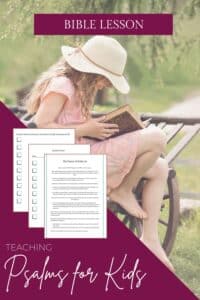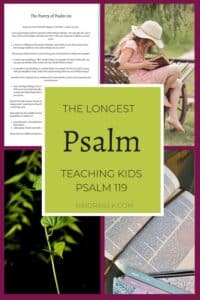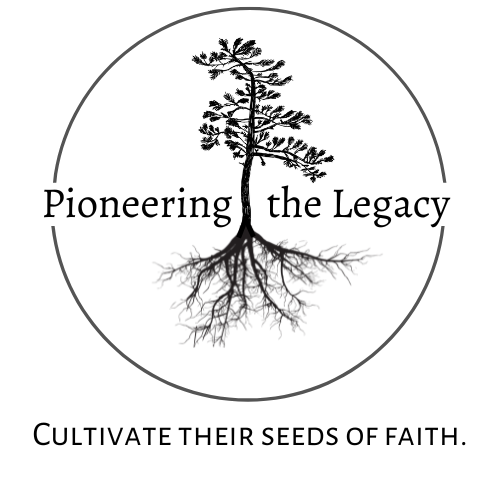Psalm 119 is known for its author’s love of God’s rules and its big expression of emotions. It’s the longest Psalm—and the longest chapter in the whole Bible! Most impressive yet, it’s a poem!
We’ll explore its poetic nature and uncover the BIG feelings it conveys. We’ll show you how to teach it to children simply—in a way that encourages kids to express their own big feelings and try their hands as young psalmists.
So, buckle up and get ready for an adventure into the world of heartfelt expressions!
And if you’d like, you can take a peek at how I preached this as a children’s sermon.
Psalm 119: An Acrostic Poem
What in the world is an acrostic poem? It’s a poem that choses a topic word and spells it down the left side of the paper. Each letter will kick off that line of the poem.
Psalm 119 takes this even further—it uses the whole Hebrew alphabet—22 letters. And uses 8 lines of poetry (in a row) starting with that same letter. In English, for example, we’d do 8 lines starting with “A” then 8 with “B” and so on. Since Hebrews didn’t think highly of rhyme, it doesn’t rhyme. However, it does use tools from a poet’s toolkit that help convey big feelings—like simile and metaphor.

Psalm 119’s Big Feelings
The author also has BIG feelings about God’s rules. He LOVES them. God’s law, judgements, and commandments bring the psalmist big joy. He tries to obey them because he knows how beneficial they are to the people who respect them.
Some of the feelings he writes about in this poetic psalm are:
- Happiness
- Rejoicing
- Comfort
- Delight
- Understanding
- Sweetness
- Joy
- Love
- Hope
But it’s not just a happy poem. It has tons of sadness. The author is going through a really hard time. Some other feelings you’ll read about are:
- Shame
- Suffering
- Affliction
- Waiting
- Persecution
- Hate
- Fear
- Longing
He’s able to get through all of that with his love of God—and of His ways and His rules.
Furthermore, he doesn’t abandon God’s rules when he feels feelings that would make it easy to. (But that’s a whole other sermon and post—coming in October).

How to Teach Psalm 119 to Kids
Weighing in at 176 verses (with the average Bible chapter being between 20-26), you might not want to read all of Psalm 119. Maybe you pick a section or a few to read. Then read again, listening for each feeling named as you go through. How many can you count? Are they happy, sad, or something different? How many have you felt? What happened that made you feel that way? Every age can answer and discuss these questions—and grow closer as everything from vulnerabilities to triumphs are shared.
Notice how the author repeatedly shows that his love of God, more specifically meditating on God’s law, got him through. Do you have a similar experience? When has setting your mind on God helped you through a hard time?
If you’re teaching to specific age groups, the youngest will have fun making their best faces to show the feelings you call out. Ages 10 and up can easily write their own acrostic poem focusing on something about God and showing how they feel about it. If they know simile, metaphor, or other figurative language, they can include some within their poem or psalm. Middle and high schoolers will be able to write more sophisticated poems conveying a wider range of feelings.

Why Teach the Poetry of It?
Because creating art is a lost art. It’s the thing we push to the bottom of the to-do list, because most find it frivolous. But it’s necessary—both studying art and making it. It allows us to reflect deeply. And it makes amazing worship.
Any of the creative arts allow for a great form of worship and way to study and learn about God—even focusing on the poetically creative parts of His Word—and to create in honor of the One who created not a strictly utilitarian world, but a beautiful one. If God is creator and we are made in the image, we should infuse beauty into the world, also.
Jesus used poetic language throughout the gospels—in parables, personification, simile, metaphor, word choice, and repetition. We should be able to recognize and know how to create this form of beauty—following in His footsteps.
So, enjoy diving into Psalm 119: a masterpiece that stirs our hearts and minds. Explore the power of poetry and feel the depths of human emotion. Let it encourage your children to express their own big feelings and seek God’s comfort.
And just maybe—create one of your own in worship to the One who made it all.
See how I lead our congregation in this same exercise.
And get your free Psalm-writing resources here:

P.S. If your family loves to read, we’ve got some good reads for you!
Children’s Books to Take It Further
There are three verse (poetic) novels I LOVE and highly recommend. They make for great reading experiencing BIG feelings vicariously through the characters. This helps kids grow emotionally in a safe way.
The first is “Gone Fishing” (ages 7-9) by Tamera Will Wissinger. Not only is this written in verse it’s a compilation of many types of poems (including rhymes) to tell the story of a boy who looks forward to a fishing trip with dad. But the morning of the trip, his little sister weasels her way in and nearly ruins the whole thing. It’s a story of a one-sided sibling rivalry that diffuses at the realization that the other one isn’t reciprocating. Fast read, great story. Tamera also writes “Gone Camping.” Both are great for a summer road trip “up north” as we do in Michigan.
The next is “The Underneath” (ages 8-12) by Kathi Appelt. This book made me cry three times. It’s a story of fall and redemption, sin and forgiveness, and has the best ending I never saw coming. If you love Shiloh, Sounder, or The Yearling, you must add this to your reading list. Phenomenal and highly awarded.
The last is “Alone” (ages 10-12) by Megan Freeman. A girl gets left behind after an evacuation. It’s a story of survival and rescue. It’s a story of learning to trust yourself in the face of the biggest enemy: loneliness. This also is a fast read, as most verse novels are.
P.P.S.
If you liked this post, check out our post on teaching kids Proverbs 31 correctly. Or our post on literal and figurative language in the Bible.


